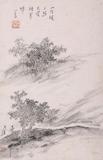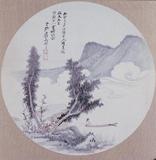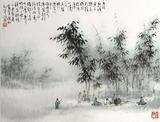集古名繪 冊 宋劉松年柳橋虛榭
推薦分享
資源連結
連結到原始資料 (您即將開啟新視窗離開本站)後設資料
- 資料識別:
- 故畫001248N000000012
- 資料類型:
- 類型:繪畫
- 型式:靜態圖像
- 著作者:
- 劉松年
- 主題與關鍵字:
- 江河、湖海 楊柳 臺閣 橋 籬笆、圍牆
- 出版者:
- 數位化執行單位:國立故宮博物院
- 格式:
- 本幅 24.7x26公分、對幅 24.7x26公分、全幅 37x73公分
- 關聯:
- 故宮書畫錄(卷六),第四冊,頁217&*石渠寶笈三編(圓明園清暉閣),第八冊,頁3650&*劉松年(約西元一一九○年-一二三○年前後),浙江錢塘人。居清波門,俗呼劉清波,又稱暗門。劉為南宋孝宗淳熙年間畫院學生,紹熙年待詔。工畫人物山水。師法張敦禮,神氣精妙,名過於師。本幅柳蔭夾峙,掩映著橋上的涼亭,園子?,靜悄悄。這些近景主題,柳橋屋樹,結合緊密,更顯示枝葉濃綠,正是盛夏時節。提上斜坡、遠山峰頂,均以石青石綠敷染,樹葉亦是。青綠畫風,南宋人喜以薄青綠罩染,本幅無款印,作者一依舊籤題,然風格似不如劉松年精細。應較晚出。&*Liu Sung-nien, a native of Hangchou, Chekiang, lived at Ch'ing-po-men, and so acquired the names Liu Ch'ing-po and An-men Liu. He was a student in the Imperial Painting Academy during the reign of Emperor Hsiao-tsung (r. 1162-1189) and later served as a Painter-in-Attendance during the Shao-hsi period (1190-1195). He was skilled in landscape and figure painting, having studied the painting methods of Chang Tung-li. Liu’s paintings possess a pure and exquisite spirit, and his fame surpassed that of his master. Towering willows shade the cool pavilion on the bridge which leads to a peaceful, quiet courtyard. The tightly structured composition draws attention to the rich green foliage which indicates that it is the height of summer. The sloped embankments, the distant mountain peaks, and the leaves of trees have been limned with malachite and azurite. In the Southern Sung, there was a taste for landscapes which where lightly colored with washes of blue and green. There are no signatures nor seals on this painting, but there is an old label attributing it to Liu Sung-nien. However, the style is inferior, so this must be a later work.&*1.王耀庭,〈宋劉松年柳橋虛榭〉,收入王耀庭編,《青綠山水畫特展圖錄》(臺北:國立故宮博物院,1995年七月初版一刷),頁82。
- 管理權:
- 國立故宮博物院
授權聯絡窗口
- 國立故宮博物院圖像授權、出版授權、影音資料授權-申請流程說明
http://www.npm.gov.tw/zh-TW/Article.aspx?sNo=03003061






